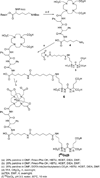68Ga-labeled inhibitors of prostate-specific membrane antigen (PSMA) for imaging prostate cancer
- PMID: 20568777
- PMCID: PMC3341619
- DOI: 10.1021/jm100623e
68Ga-labeled inhibitors of prostate-specific membrane antigen (PSMA) for imaging prostate cancer
Abstract
Gallium-68 is a generator-produced radionuclide for positron emission tomography (PET) that is being increasingly used for radiolabeling of tumor-targeting peptides. Compounds [(68)Ga]3 and [(68)Ga]6 are high-affinity urea-based inhibitors of the prostate-specific membrane antigen (PSMA) that were synthesized in decay-uncorrected yields ranging from 60% to 70% and radiochemical purities of more than 99%. Compound [(68)Ga]3 demonstrated 3.78 +/- 0.90% injected dose per gram of tissue (%ID/g) within PSMA+ PIP tumor at 30 min postinjection, while [(68)Ga]6 showed a 2 h PSMA+ PIP tumor uptake value of 3.29 +/- 0.77 %ID/g. Target (PSMA+ PIP) to nontarget (PSMA- flu) ratios were 4.6 and 18.3, respectively, at those time points. Both compounds delineated tumor clearly by small animal PET. The urea series of imaging agents for PSMA can be radiolabeled with (68)Ga, a cyclotron-free isotope useful for clinical PET studies, with maintenance of target specificity.
Figures





References
-
- Cancer Facts & Figures. Atlanta, GA: American Cancer Society; 2009.
-
- Ghosh A, Heston WD. Tumor target prostate specific membrane antigen (PSMA) and its regulation in prostate cancer. J. Cell Biochem. 2004;91:528–539. - PubMed
-
- Milowsky MI, Nanus DM, Kostakoglu L, Sheehan CE, Vallabhajosula S, Goldsmith SJ, Ross JS, Bander NH. Vascular targeted therapy with anti-prostate-specific membrane antigen monoclonal antibody J591 in advanced solid tumors. J. Clin. Oncol. 2007;25:540–547. - PubMed
-
- Kowol CR, Berger R, Eichinger R, Roller A, Jakupec MA, Schmidt PP, Arion VB, Keppler BK. Gallium(III) and iron(III) complexes of alpha-N-heterocyclic thiosemicarbazones: synthesis, characterization, cytotoxicity, and interaction with ribonucleotide reductase. J. Med. Chem. 2007;50:1254–1265. - PubMed
-
- Kowol CR, Trondl R, Heffeter P, Arion VB, Jakupec MA, Roller A, Galanski M, Berger W, Keppler BK. Impact of metal coordination on cytotoxicity of 3-aminopyridine-2-carboxaldehyde thiosemicarbazone (triapine) and novel insights into terminal dimethylation. J. Med. Chem. 2009:5032–5043. - PubMed
Publication types
MeSH terms
Substances
Grants and funding
LinkOut - more resources
Full Text Sources
Other Literature Sources
Medical
Miscellaneous

